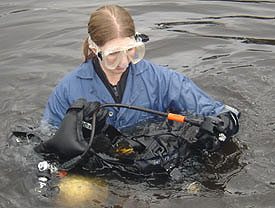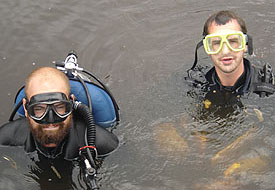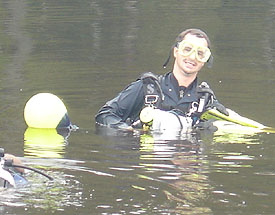ECU's 2006 Fall Field School
Project Journal
14 September 2006
By Joe Hoyt

Working underwater we are trained to manage and prepare for several scenarios that could be dangerous. Steps are taken to ensure that the effects of zero visibility, long exposure to the cold, barotraumas, and hazardous marine life are mitigated. Never did we consider the insidious possibility of lymphoma. As dredging operations progressed yesterday some curious particulate matter became evident.

Trish dons her gear for another day of work in the water.
A white waxy/oily substance was discovered, which Adam, whose father has worked with toxic waste cleanup, calmly asserted may be rich in PCB's. Of course he would only disclose this possibility after he was satisfied with how much I handled it with my bare hands. As PCB's don't have the best of reputations, particularly for bathing, it was decided that until we had results on water tests, dredging would cease. The proper officials were called in to ascertain exactly what we are dealing with.

Joe and Adam return from taking diagnostic measurements on a couple of vessels.
When we arrived on site today it was overcast and raining steadily. Leaving vessel 1, the team set out to gather as much information about the remaining five vessels as Site A as could be gleaned without disturbing the river-bed. Essentially what we were able to record were the sided and molded dimensions of scantlings such as the keelson, futtocks, ceiling and hull planking, as well as recording some overall dimensions. This will allow us to at least plot the vessels into the shoreline survey which had been previously completed.

Yellow mask: $50; Yellow fins $70; Yellow Octopus Regulator: $100; Having your diving wardrobe color coordinated with a yellow marker buoy: priceless
Buddy teams were sent out to each vessel, but progress was impeded by the inclement weather and the nagging possibility of developing super-human powers from the unknown concoctions contained within the sludge. However, we soldiered on…why? For knowledge, that's why, the only thirst these squalid waters could ever hope to quench.
By the end of day we had gained enough information so that later we will be able to produce some quality mud-maps…a term that now has a greater meaning. Tomorrow we will leave Site A behind and begin work at a different place on the river.
For more information you can visit the ECU website at:
http://www.ecu.edu/maritime/index.htm
Return to Project Journal home page.

